Resourcing the Organisation HRM 13 Report: Labor Market Dynamics
VerifiedAdded on 2022/08/25
|20
|4376
|33
Report
AI Summary
This report provides a comprehensive analysis of tight and loose labor markets, exploring their definitions, characteristics, and practical examples from the UK and Saudi Arabia. It examines how labor market conditions impact talent planning and resourcing within organizations, specifically focusing on Tesco. The report discusses the initiation of zero-hour contracts, the growth of the female labor force, and the rise of self-employment, as well as the importance of real wage growth and labor market flexibility. Furthermore, it critically evaluates HR planning activities, including the four key steps of the HRP process: analyzing the present supply of labor, forecasting labor demand, identifying the gaps, and creating action plans. The report also highlights the importance of employee retention and the need for organizations to adapt to changing labor market dynamics to attract and retain talent.
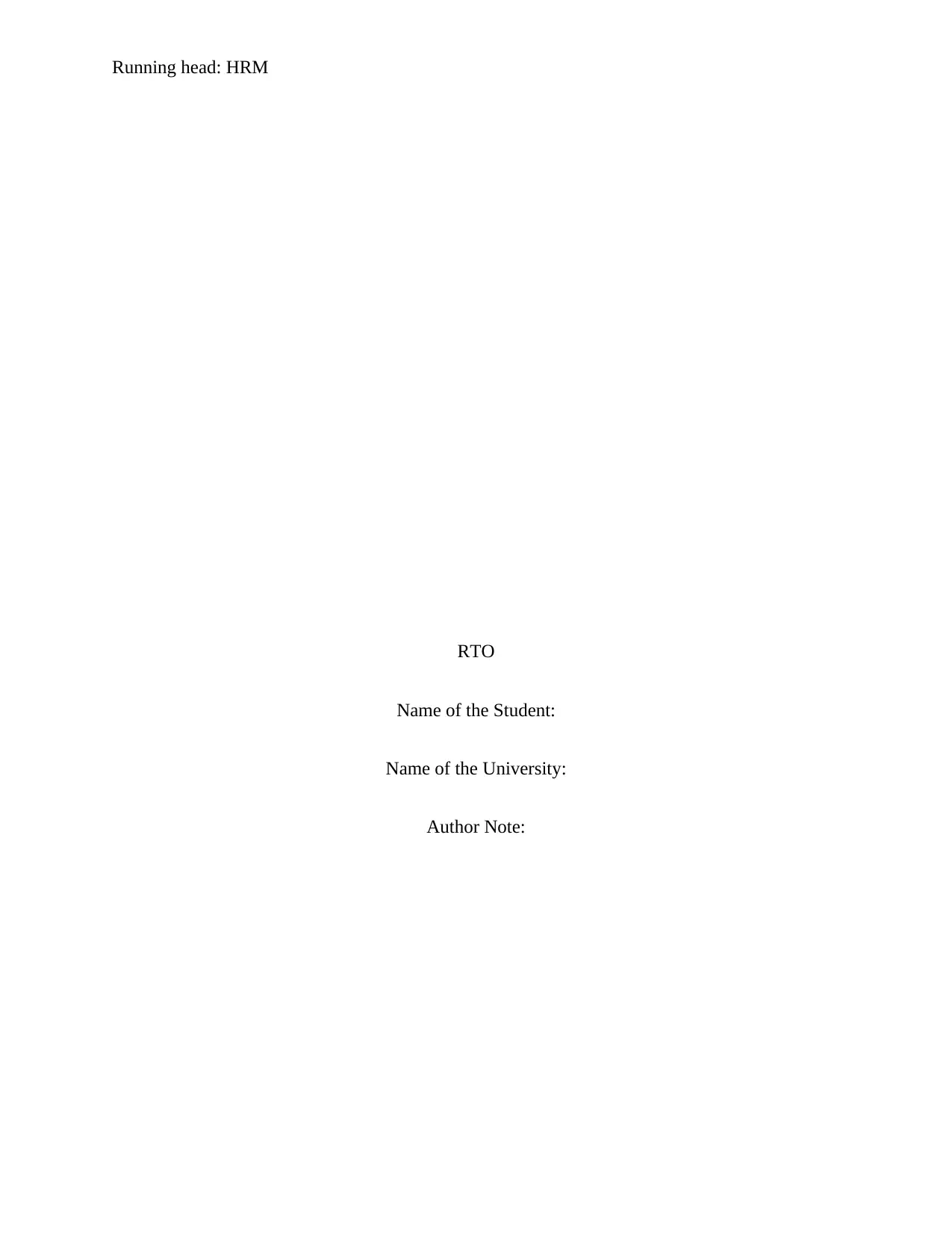
Running head: HRM
RTO
Name of the Student:
Name of the University:
Author Note:
RTO
Name of the Student:
Name of the University:
Author Note:
Paraphrase This Document
Need a fresh take? Get an instant paraphrase of this document with our AI Paraphraser
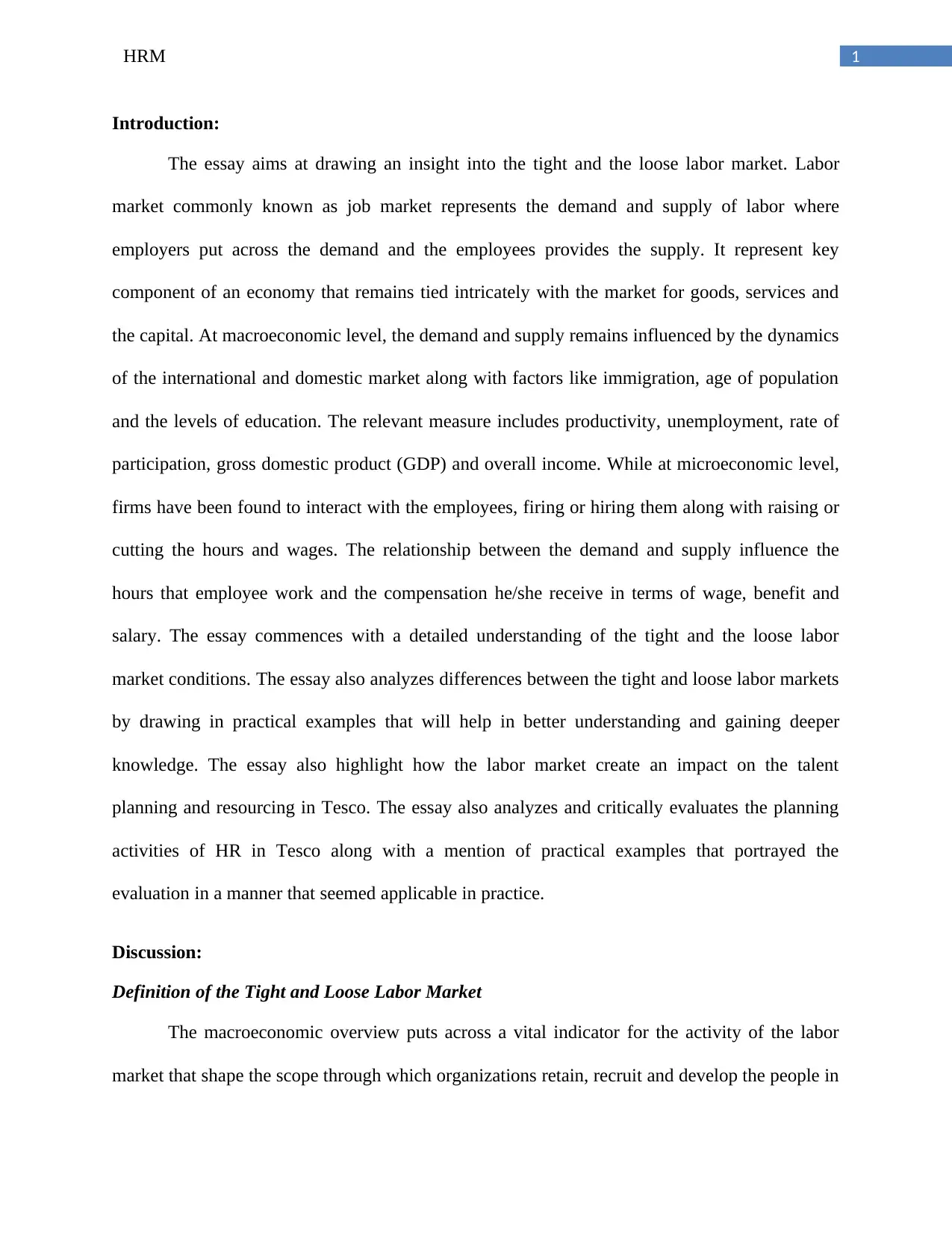
HRM 1
Introduction:
The essay aims at drawing an insight into the tight and the loose labor market. Labor
market commonly known as job market represents the demand and supply of labor where
employers put across the demand and the employees provides the supply. It represent key
component of an economy that remains tied intricately with the market for goods, services and
the capital. At macroeconomic level, the demand and supply remains influenced by the dynamics
of the international and domestic market along with factors like immigration, age of population
and the levels of education. The relevant measure includes productivity, unemployment, rate of
participation, gross domestic product (GDP) and overall income. While at microeconomic level,
firms have been found to interact with the employees, firing or hiring them along with raising or
cutting the hours and wages. The relationship between the demand and supply influence the
hours that employee work and the compensation he/she receive in terms of wage, benefit and
salary. The essay commences with a detailed understanding of the tight and the loose labor
market conditions. The essay also analyzes differences between the tight and loose labor markets
by drawing in practical examples that will help in better understanding and gaining deeper
knowledge. The essay also highlight how the labor market create an impact on the talent
planning and resourcing in Tesco. The essay also analyzes and critically evaluates the planning
activities of HR in Tesco along with a mention of practical examples that portrayed the
evaluation in a manner that seemed applicable in practice.
Discussion:
Definition of the Tight and Loose Labor Market
The macroeconomic overview puts across a vital indicator for the activity of the labor
market that shape the scope through which organizations retain, recruit and develop the people in
Introduction:
The essay aims at drawing an insight into the tight and the loose labor market. Labor
market commonly known as job market represents the demand and supply of labor where
employers put across the demand and the employees provides the supply. It represent key
component of an economy that remains tied intricately with the market for goods, services and
the capital. At macroeconomic level, the demand and supply remains influenced by the dynamics
of the international and domestic market along with factors like immigration, age of population
and the levels of education. The relevant measure includes productivity, unemployment, rate of
participation, gross domestic product (GDP) and overall income. While at microeconomic level,
firms have been found to interact with the employees, firing or hiring them along with raising or
cutting the hours and wages. The relationship between the demand and supply influence the
hours that employee work and the compensation he/she receive in terms of wage, benefit and
salary. The essay commences with a detailed understanding of the tight and the loose labor
market conditions. The essay also analyzes differences between the tight and loose labor markets
by drawing in practical examples that will help in better understanding and gaining deeper
knowledge. The essay also highlight how the labor market create an impact on the talent
planning and resourcing in Tesco. The essay also analyzes and critically evaluates the planning
activities of HR in Tesco along with a mention of practical examples that portrayed the
evaluation in a manner that seemed applicable in practice.
Discussion:
Definition of the Tight and Loose Labor Market
The macroeconomic overview puts across a vital indicator for the activity of the labor
market that shape the scope through which organizations retain, recruit and develop the people in
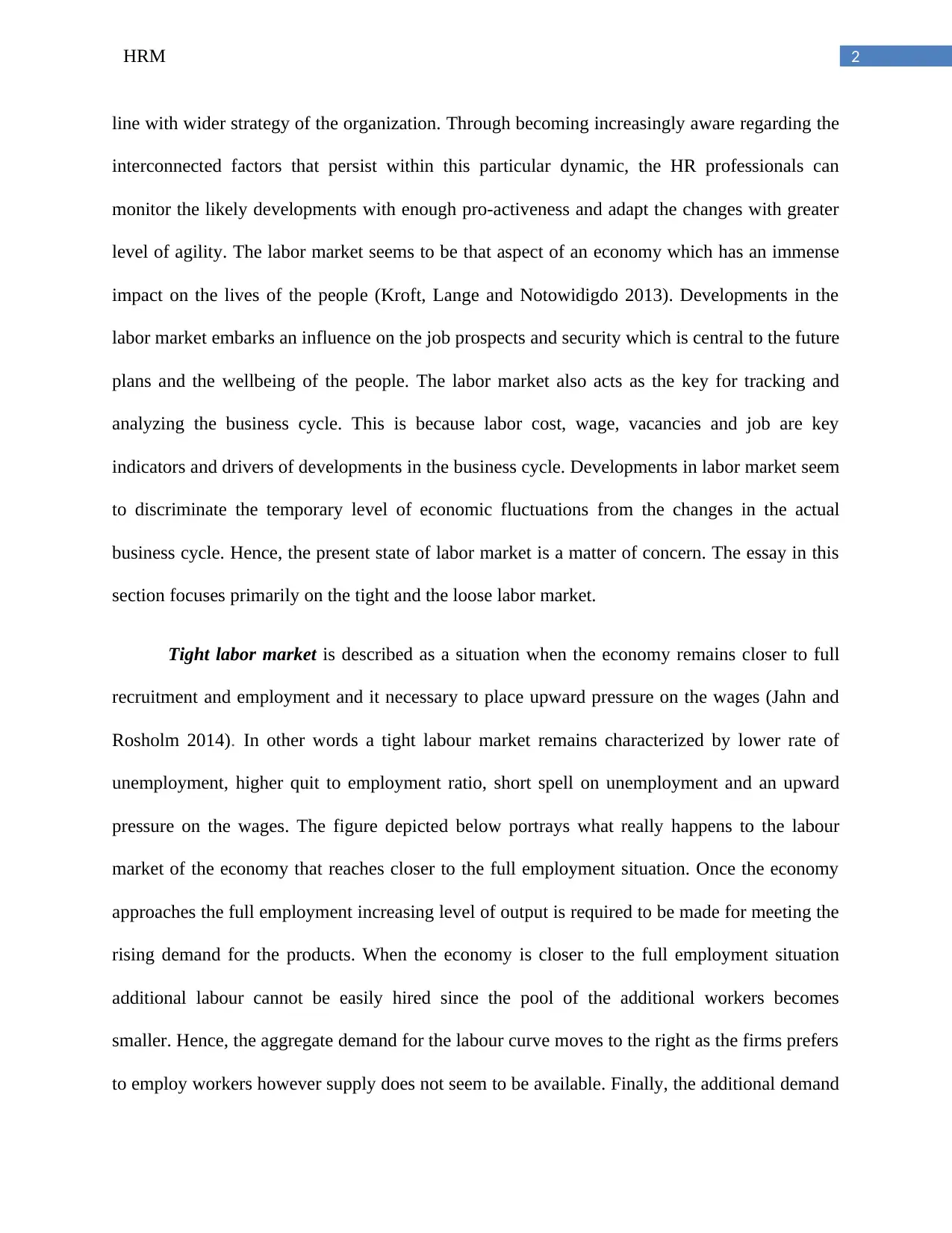
2HRM
line with wider strategy of the organization. Through becoming increasingly aware regarding the
interconnected factors that persist within this particular dynamic, the HR professionals can
monitor the likely developments with enough pro-activeness and adapt the changes with greater
level of agility. The labor market seems to be that aspect of an economy which has an immense
impact on the lives of the people (Kroft, Lange and Notowidigdo 2013). Developments in the
labor market embarks an influence on the job prospects and security which is central to the future
plans and the wellbeing of the people. The labor market also acts as the key for tracking and
analyzing the business cycle. This is because labor cost, wage, vacancies and job are key
indicators and drivers of developments in the business cycle. Developments in labor market seem
to discriminate the temporary level of economic fluctuations from the changes in the actual
business cycle. Hence, the present state of labor market is a matter of concern. The essay in this
section focuses primarily on the tight and the loose labor market.
Tight labor market is described as a situation when the economy remains closer to full
recruitment and employment and it necessary to place upward pressure on the wages (Jahn and
Rosholm 2014). In other words a tight labour market remains characterized by lower rate of
unemployment, higher quit to employment ratio, short spell on unemployment and an upward
pressure on the wages. The figure depicted below portrays what really happens to the labour
market of the economy that reaches closer to the full employment situation. Once the economy
approaches the full employment increasing level of output is required to be made for meeting the
rising demand for the products. When the economy is closer to the full employment situation
additional labour cannot be easily hired since the pool of the additional workers becomes
smaller. Hence, the aggregate demand for the labour curve moves to the right as the firms prefers
to employ workers however supply does not seem to be available. Finally, the additional demand
line with wider strategy of the organization. Through becoming increasingly aware regarding the
interconnected factors that persist within this particular dynamic, the HR professionals can
monitor the likely developments with enough pro-activeness and adapt the changes with greater
level of agility. The labor market seems to be that aspect of an economy which has an immense
impact on the lives of the people (Kroft, Lange and Notowidigdo 2013). Developments in the
labor market embarks an influence on the job prospects and security which is central to the future
plans and the wellbeing of the people. The labor market also acts as the key for tracking and
analyzing the business cycle. This is because labor cost, wage, vacancies and job are key
indicators and drivers of developments in the business cycle. Developments in labor market seem
to discriminate the temporary level of economic fluctuations from the changes in the actual
business cycle. Hence, the present state of labor market is a matter of concern. The essay in this
section focuses primarily on the tight and the loose labor market.
Tight labor market is described as a situation when the economy remains closer to full
recruitment and employment and it necessary to place upward pressure on the wages (Jahn and
Rosholm 2014). In other words a tight labour market remains characterized by lower rate of
unemployment, higher quit to employment ratio, short spell on unemployment and an upward
pressure on the wages. The figure depicted below portrays what really happens to the labour
market of the economy that reaches closer to the full employment situation. Once the economy
approaches the full employment increasing level of output is required to be made for meeting the
rising demand for the products. When the economy is closer to the full employment situation
additional labour cannot be easily hired since the pool of the additional workers becomes
smaller. Hence, the aggregate demand for the labour curve moves to the right as the firms prefers
to employ workers however supply does not seem to be available. Finally, the additional demand
⊘ This is a preview!⊘
Do you want full access?
Subscribe today to unlock all pages.

Trusted by 1+ million students worldwide
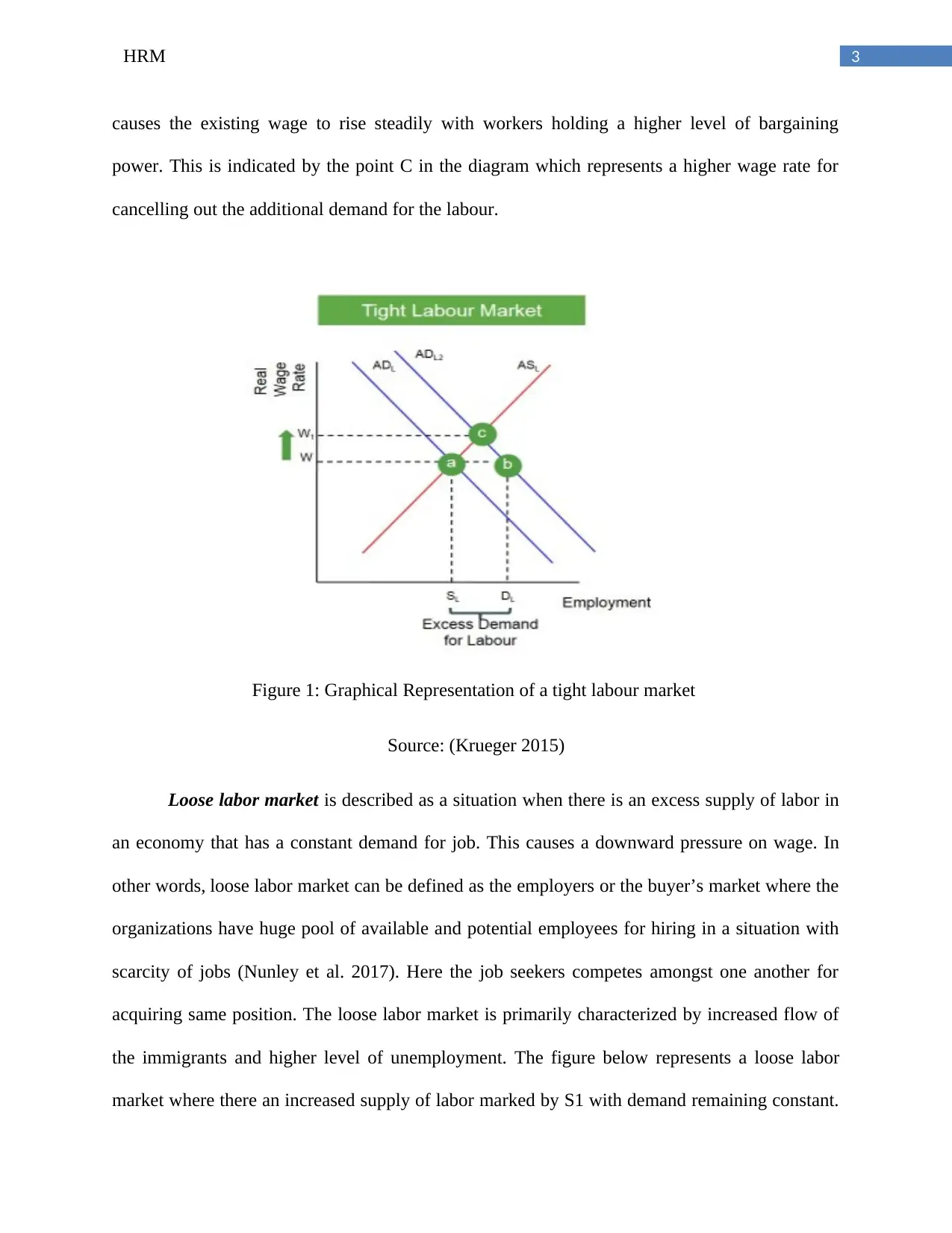
3HRM
causes the existing wage to rise steadily with workers holding a higher level of bargaining
power. This is indicated by the point C in the diagram which represents a higher wage rate for
cancelling out the additional demand for the labour.
Figure 1: Graphical Representation of a tight labour market
Source: (Krueger 2015)
Loose labor market is described as a situation when there is an excess supply of labor in
an economy that has a constant demand for job. This causes a downward pressure on wage. In
other words, loose labor market can be defined as the employers or the buyer’s market where the
organizations have huge pool of available and potential employees for hiring in a situation with
scarcity of jobs (Nunley et al. 2017). Here the job seekers competes amongst one another for
acquiring same position. The loose labor market is primarily characterized by increased flow of
the immigrants and higher level of unemployment. The figure below represents a loose labor
market where there an increased supply of labor marked by S1 with demand remaining constant.
causes the existing wage to rise steadily with workers holding a higher level of bargaining
power. This is indicated by the point C in the diagram which represents a higher wage rate for
cancelling out the additional demand for the labour.
Figure 1: Graphical Representation of a tight labour market
Source: (Krueger 2015)
Loose labor market is described as a situation when there is an excess supply of labor in
an economy that has a constant demand for job. This causes a downward pressure on wage. In
other words, loose labor market can be defined as the employers or the buyer’s market where the
organizations have huge pool of available and potential employees for hiring in a situation with
scarcity of jobs (Nunley et al. 2017). Here the job seekers competes amongst one another for
acquiring same position. The loose labor market is primarily characterized by increased flow of
the immigrants and higher level of unemployment. The figure below represents a loose labor
market where there an increased supply of labor marked by S1 with demand remaining constant.
Paraphrase This Document
Need a fresh take? Get an instant paraphrase of this document with our AI Paraphraser
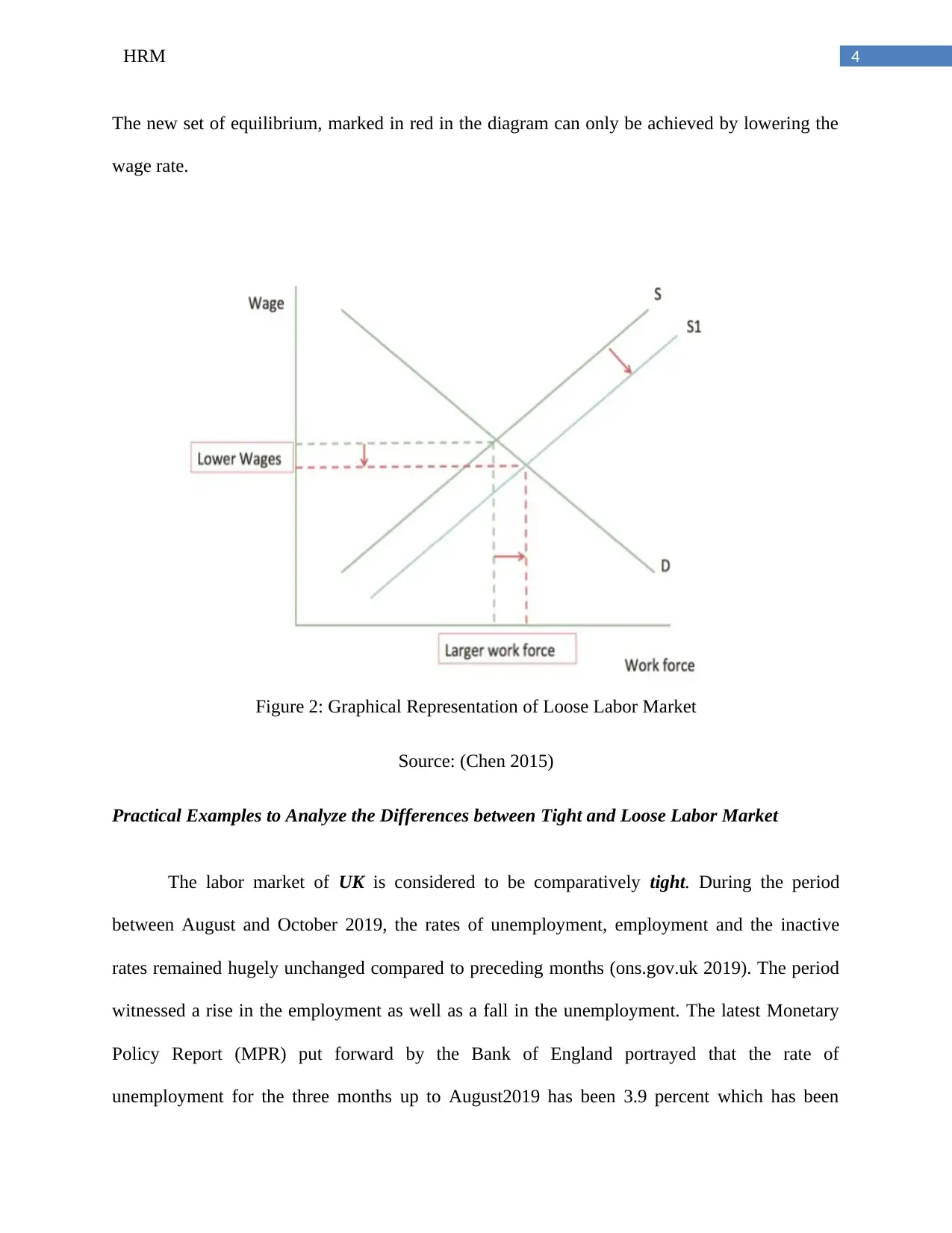
4HRM
The new set of equilibrium, marked in red in the diagram can only be achieved by lowering the
wage rate.
Figure 2: Graphical Representation of Loose Labor Market
Source: (Chen 2015)
Practical Examples to Analyze the Differences between Tight and Loose Labor Market
The labor market of UK is considered to be comparatively tight. During the period
between August and October 2019, the rates of unemployment, employment and the inactive
rates remained hugely unchanged compared to preceding months (ons.gov.uk 2019). The period
witnessed a rise in the employment as well as a fall in the unemployment. The latest Monetary
Policy Report (MPR) put forward by the Bank of England portrayed that the rate of
unemployment for the three months up to August2019 has been 3.9 percent which has been
The new set of equilibrium, marked in red in the diagram can only be achieved by lowering the
wage rate.
Figure 2: Graphical Representation of Loose Labor Market
Source: (Chen 2015)
Practical Examples to Analyze the Differences between Tight and Loose Labor Market
The labor market of UK is considered to be comparatively tight. During the period
between August and October 2019, the rates of unemployment, employment and the inactive
rates remained hugely unchanged compared to preceding months (ons.gov.uk 2019). The period
witnessed a rise in the employment as well as a fall in the unemployment. The latest Monetary
Policy Report (MPR) put forward by the Bank of England portrayed that the rate of
unemployment for the three months up to August2019 has been 3.9 percent which has been
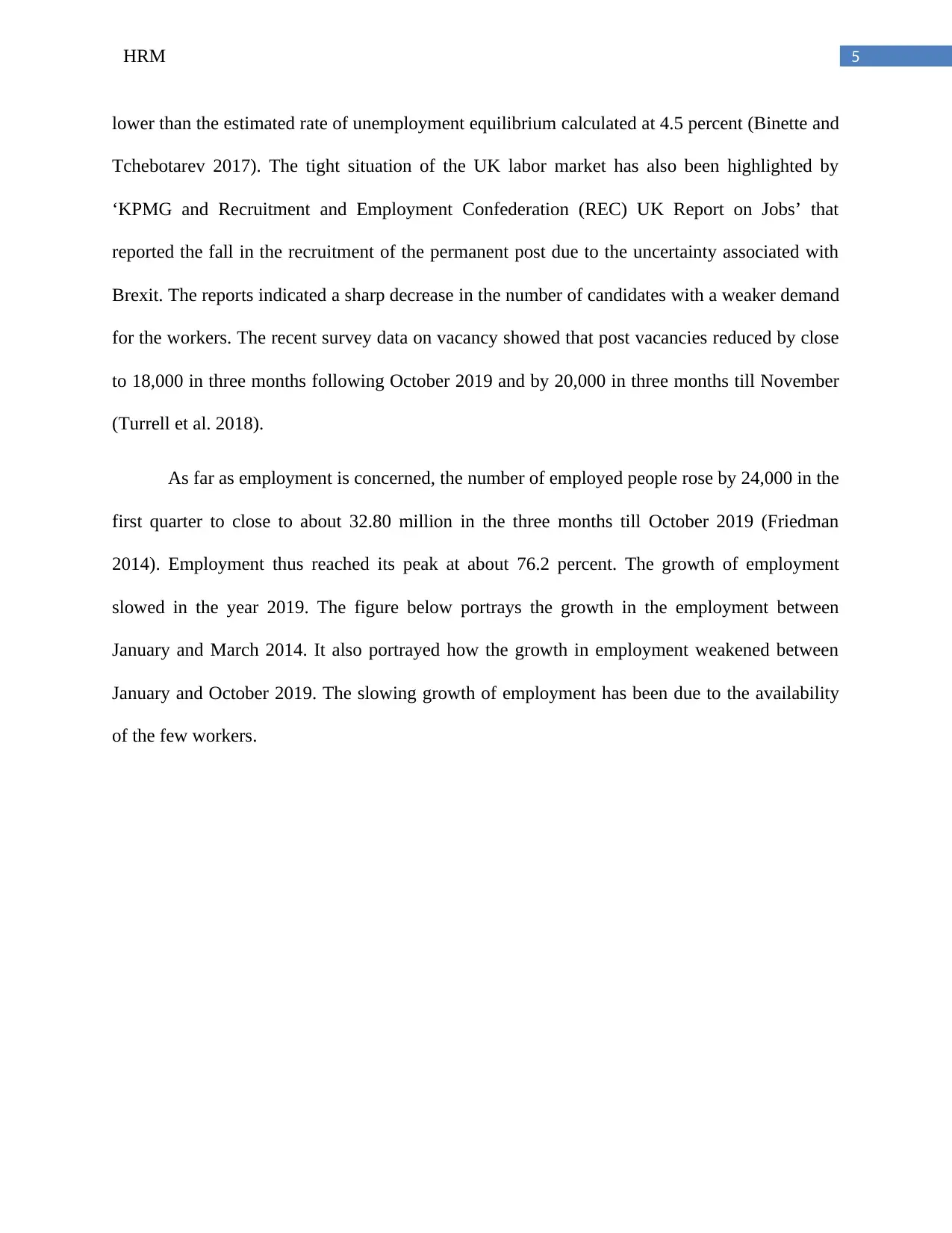
5HRM
lower than the estimated rate of unemployment equilibrium calculated at 4.5 percent (Binette and
Tchebotarev 2017). The tight situation of the UK labor market has also been highlighted by
‘KPMG and Recruitment and Employment Confederation (REC) UK Report on Jobs’ that
reported the fall in the recruitment of the permanent post due to the uncertainty associated with
Brexit. The reports indicated a sharp decrease in the number of candidates with a weaker demand
for the workers. The recent survey data on vacancy showed that post vacancies reduced by close
to 18,000 in three months following October 2019 and by 20,000 in three months till November
(Turrell et al. 2018).
As far as employment is concerned, the number of employed people rose by 24,000 in the
first quarter to close to about 32.80 million in the three months till October 2019 (Friedman
2014). Employment thus reached its peak at about 76.2 percent. The growth of employment
slowed in the year 2019. The figure below portrays the growth in the employment between
January and March 2014. It also portrayed how the growth in employment weakened between
January and October 2019. The slowing growth of employment has been due to the availability
of the few workers.
lower than the estimated rate of unemployment equilibrium calculated at 4.5 percent (Binette and
Tchebotarev 2017). The tight situation of the UK labor market has also been highlighted by
‘KPMG and Recruitment and Employment Confederation (REC) UK Report on Jobs’ that
reported the fall in the recruitment of the permanent post due to the uncertainty associated with
Brexit. The reports indicated a sharp decrease in the number of candidates with a weaker demand
for the workers. The recent survey data on vacancy showed that post vacancies reduced by close
to 18,000 in three months following October 2019 and by 20,000 in three months till November
(Turrell et al. 2018).
As far as employment is concerned, the number of employed people rose by 24,000 in the
first quarter to close to about 32.80 million in the three months till October 2019 (Friedman
2014). Employment thus reached its peak at about 76.2 percent. The growth of employment
slowed in the year 2019. The figure below portrays the growth in the employment between
January and March 2014. It also portrayed how the growth in employment weakened between
January and October 2019. The slowing growth of employment has been due to the availability
of the few workers.
⊘ This is a preview!⊘
Do you want full access?
Subscribe today to unlock all pages.

Trusted by 1+ million students worldwide
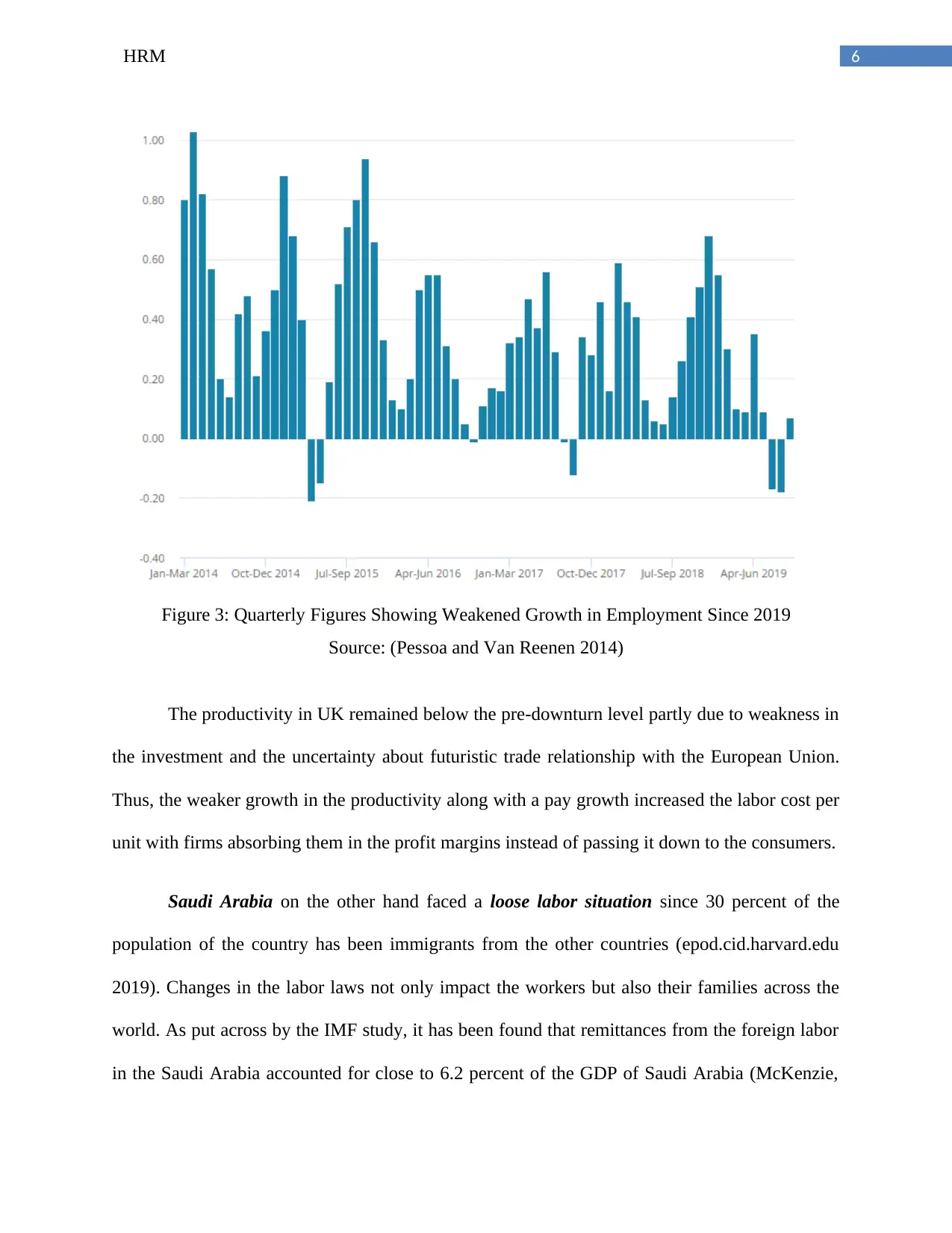
6HRM
Figure 3: Quarterly Figures Showing Weakened Growth in Employment Since 2019
Source: (Pessoa and Van Reenen 2014)
The productivity in UK remained below the pre-downturn level partly due to weakness in
the investment and the uncertainty about futuristic trade relationship with the European Union.
Thus, the weaker growth in the productivity along with a pay growth increased the labor cost per
unit with firms absorbing them in the profit margins instead of passing it down to the consumers.
Saudi Arabia on the other hand faced a loose labor situation since 30 percent of the
population of the country has been immigrants from the other countries (epod.cid.harvard.edu
2019). Changes in the labor laws not only impact the workers but also their families across the
world. As put across by the IMF study, it has been found that remittances from the foreign labor
in the Saudi Arabia accounted for close to 6.2 percent of the GDP of Saudi Arabia (McKenzie,
Figure 3: Quarterly Figures Showing Weakened Growth in Employment Since 2019
Source: (Pessoa and Van Reenen 2014)
The productivity in UK remained below the pre-downturn level partly due to weakness in
the investment and the uncertainty about futuristic trade relationship with the European Union.
Thus, the weaker growth in the productivity along with a pay growth increased the labor cost per
unit with firms absorbing them in the profit margins instead of passing it down to the consumers.
Saudi Arabia on the other hand faced a loose labor situation since 30 percent of the
population of the country has been immigrants from the other countries (epod.cid.harvard.edu
2019). Changes in the labor laws not only impact the workers but also their families across the
world. As put across by the IMF study, it has been found that remittances from the foreign labor
in the Saudi Arabia accounted for close to 6.2 percent of the GDP of Saudi Arabia (McKenzie,
Paraphrase This Document
Need a fresh take? Get an instant paraphrase of this document with our AI Paraphraser
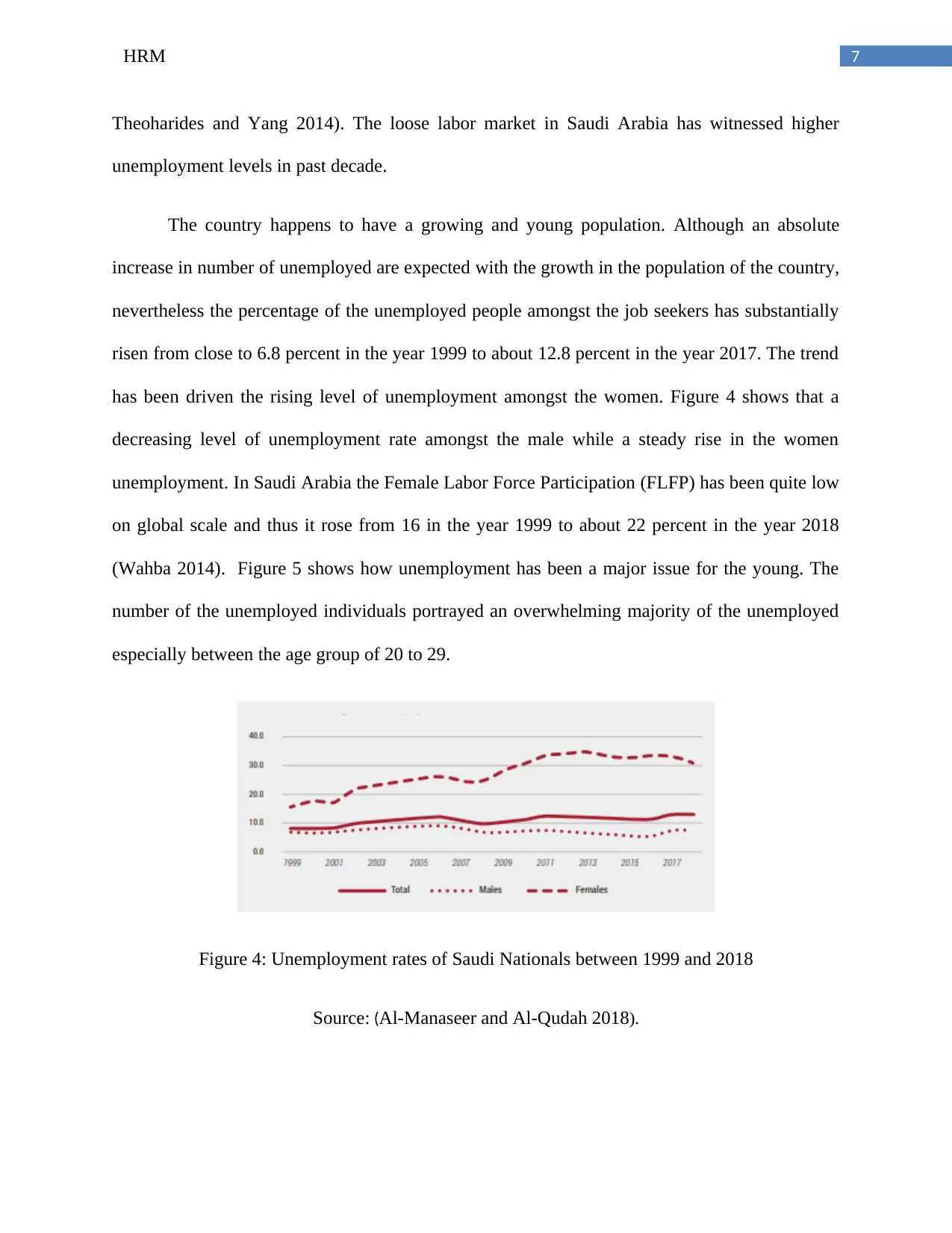
7HRM
Theoharides and Yang 2014). The loose labor market in Saudi Arabia has witnessed higher
unemployment levels in past decade.
The country happens to have a growing and young population. Although an absolute
increase in number of unemployed are expected with the growth in the population of the country,
nevertheless the percentage of the unemployed people amongst the job seekers has substantially
risen from close to 6.8 percent in the year 1999 to about 12.8 percent in the year 2017. The trend
has been driven the rising level of unemployment amongst the women. Figure 4 shows that a
decreasing level of unemployment rate amongst the male while a steady rise in the women
unemployment. In Saudi Arabia the Female Labor Force Participation (FLFP) has been quite low
on global scale and thus it rose from 16 in the year 1999 to about 22 percent in the year 2018
(Wahba 2014). Figure 5 shows how unemployment has been a major issue for the young. The
number of the unemployed individuals portrayed an overwhelming majority of the unemployed
especially between the age group of 20 to 29.
Figure 4: Unemployment rates of Saudi Nationals between 1999 and 2018
Source: (Al-Manaseer and Al-Qudah 2018).
Theoharides and Yang 2014). The loose labor market in Saudi Arabia has witnessed higher
unemployment levels in past decade.
The country happens to have a growing and young population. Although an absolute
increase in number of unemployed are expected with the growth in the population of the country,
nevertheless the percentage of the unemployed people amongst the job seekers has substantially
risen from close to 6.8 percent in the year 1999 to about 12.8 percent in the year 2017. The trend
has been driven the rising level of unemployment amongst the women. Figure 4 shows that a
decreasing level of unemployment rate amongst the male while a steady rise in the women
unemployment. In Saudi Arabia the Female Labor Force Participation (FLFP) has been quite low
on global scale and thus it rose from 16 in the year 1999 to about 22 percent in the year 2018
(Wahba 2014). Figure 5 shows how unemployment has been a major issue for the young. The
number of the unemployed individuals portrayed an overwhelming majority of the unemployed
especially between the age group of 20 to 29.
Figure 4: Unemployment rates of Saudi Nationals between 1999 and 2018
Source: (Al-Manaseer and Al-Qudah 2018).
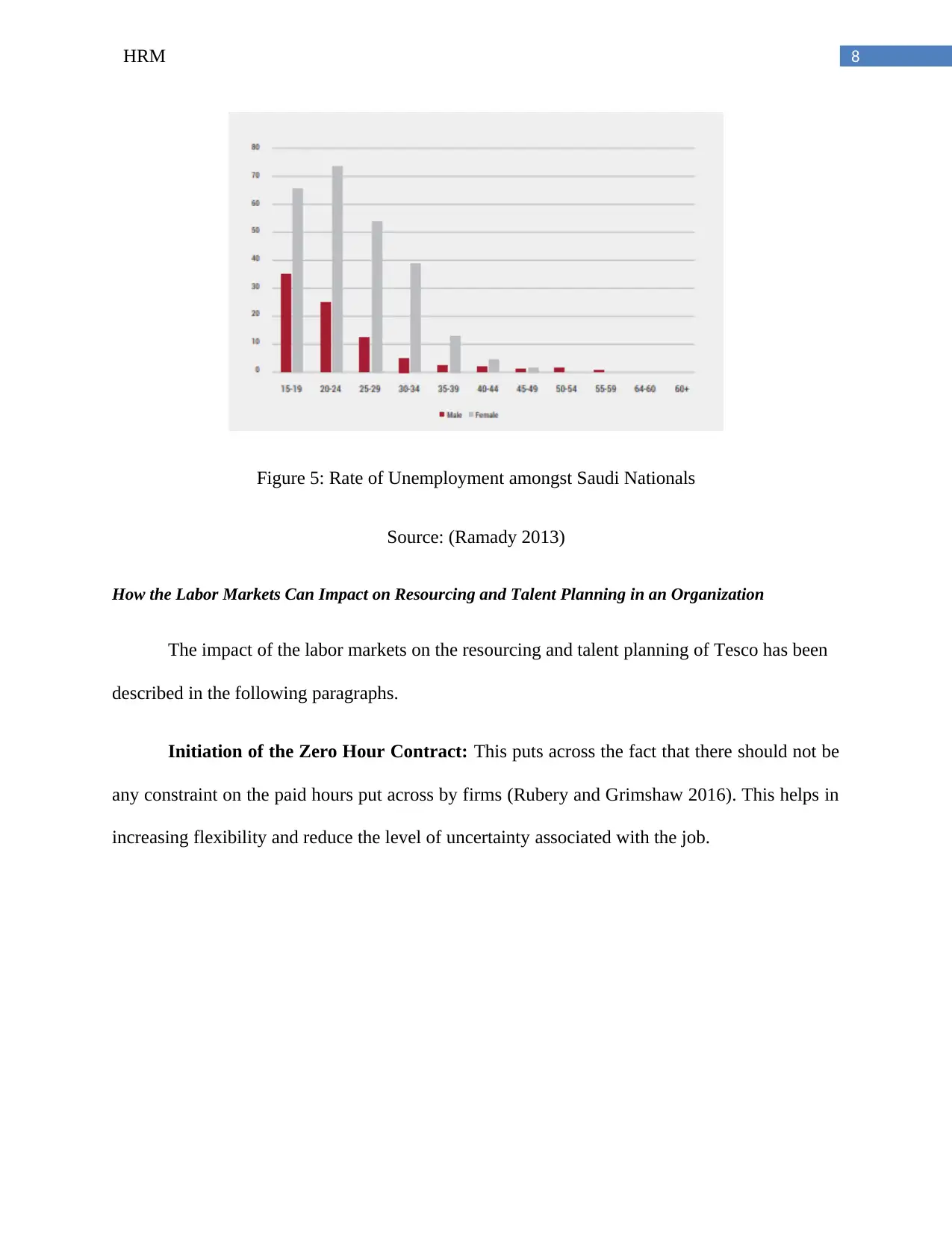
8HRM
Figure 5: Rate of Unemployment amongst Saudi Nationals
Source: (Ramady 2013)
How the Labor Markets Can Impact on Resourcing and Talent Planning in an Organization
The impact of the labor markets on the resourcing and talent planning of Tesco has been
described in the following paragraphs.
Initiation of the Zero Hour Contract: This puts across the fact that there should not be
any constraint on the paid hours put across by firms (Rubery and Grimshaw 2016). This helps in
increasing flexibility and reduce the level of uncertainty associated with the job.
Figure 5: Rate of Unemployment amongst Saudi Nationals
Source: (Ramady 2013)
How the Labor Markets Can Impact on Resourcing and Talent Planning in an Organization
The impact of the labor markets on the resourcing and talent planning of Tesco has been
described in the following paragraphs.
Initiation of the Zero Hour Contract: This puts across the fact that there should not be
any constraint on the paid hours put across by firms (Rubery and Grimshaw 2016). This helps in
increasing flexibility and reduce the level of uncertainty associated with the job.
⊘ This is a preview!⊘
Do you want full access?
Subscribe today to unlock all pages.

Trusted by 1+ million students worldwide
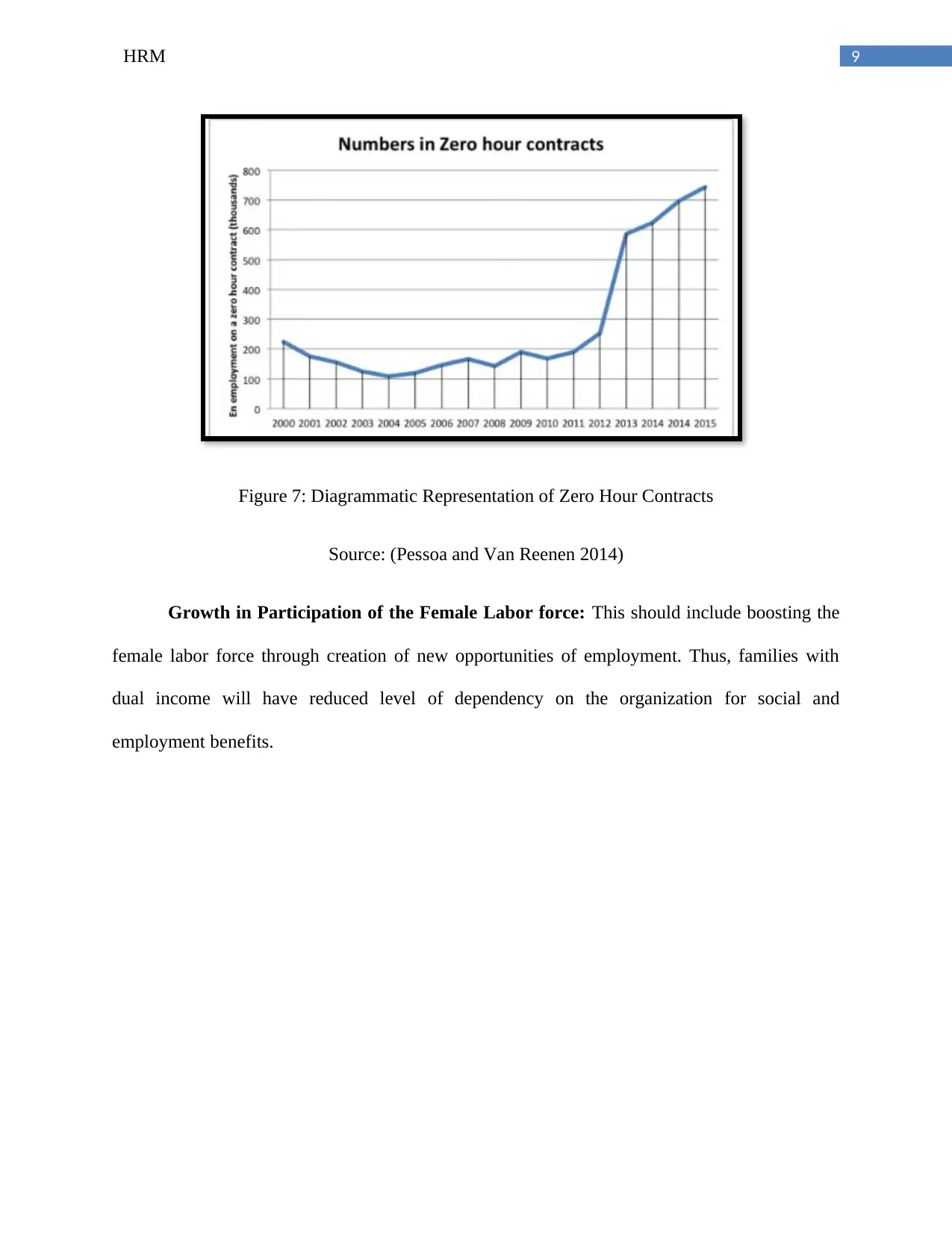
9HRM
Figure 7: Diagrammatic Representation of Zero Hour Contracts
Source: (Pessoa and Van Reenen 2014)
Growth in Participation of the Female Labor force: This should include boosting the
female labor force through creation of new opportunities of employment. Thus, families with
dual income will have reduced level of dependency on the organization for social and
employment benefits.
Figure 7: Diagrammatic Representation of Zero Hour Contracts
Source: (Pessoa and Van Reenen 2014)
Growth in Participation of the Female Labor force: This should include boosting the
female labor force through creation of new opportunities of employment. Thus, families with
dual income will have reduced level of dependency on the organization for social and
employment benefits.
Paraphrase This Document
Need a fresh take? Get an instant paraphrase of this document with our AI Paraphraser
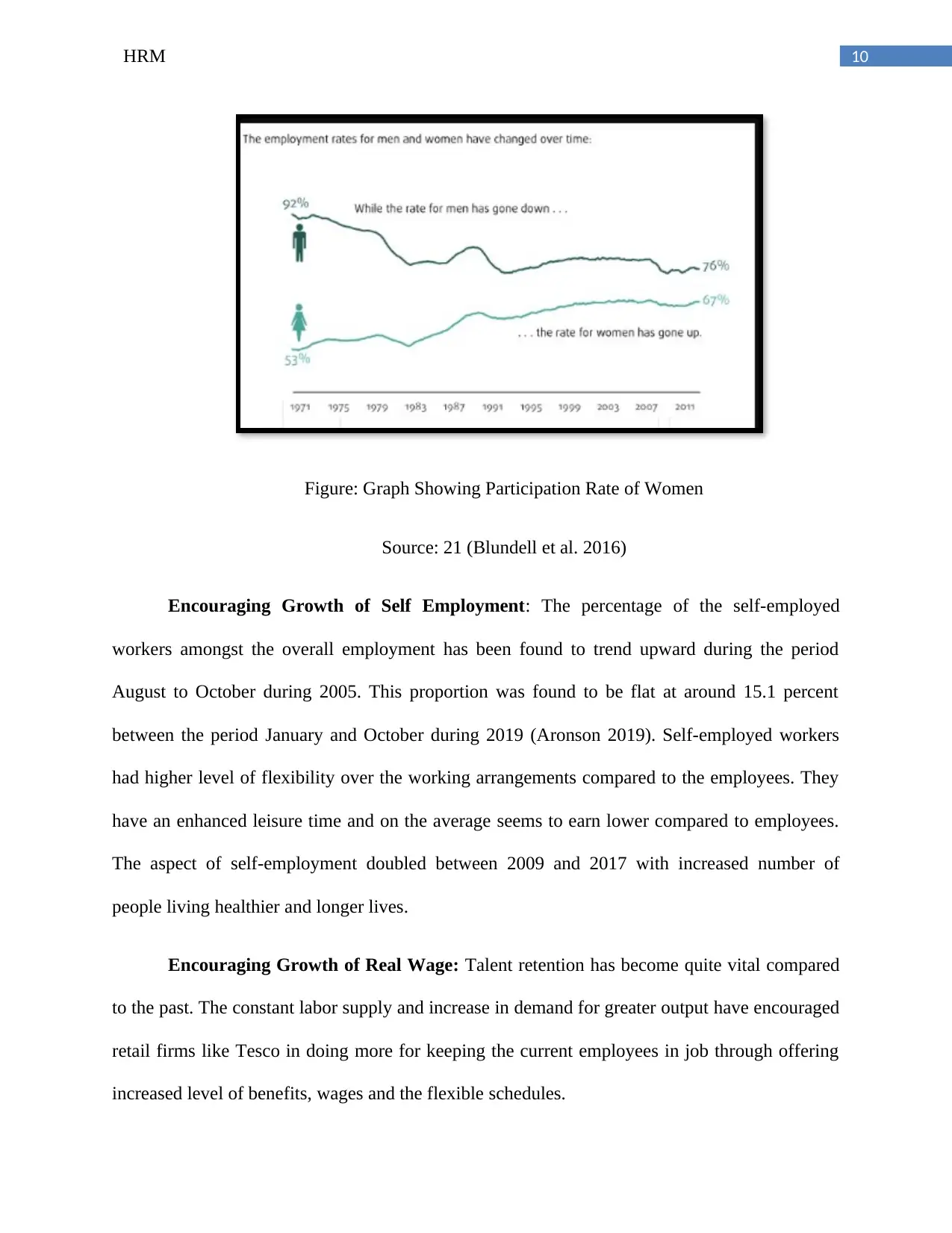
10HRM
Figure: Graph Showing Participation Rate of Women
Source: 21 (Blundell et al. 2016)
Encouraging Growth of Self Employment: The percentage of the self-employed
workers amongst the overall employment has been found to trend upward during the period
August to October during 2005. This proportion was found to be flat at around 15.1 percent
between the period January and October during 2019 (Aronson 2019). Self-employed workers
had higher level of flexibility over the working arrangements compared to the employees. They
have an enhanced leisure time and on the average seems to earn lower compared to employees.
The aspect of self-employment doubled between 2009 and 2017 with increased number of
people living healthier and longer lives.
Encouraging Growth of Real Wage: Talent retention has become quite vital compared
to the past. The constant labor supply and increase in demand for greater output have encouraged
retail firms like Tesco in doing more for keeping the current employees in job through offering
increased level of benefits, wages and the flexible schedules.
Figure: Graph Showing Participation Rate of Women
Source: 21 (Blundell et al. 2016)
Encouraging Growth of Self Employment: The percentage of the self-employed
workers amongst the overall employment has been found to trend upward during the period
August to October during 2005. This proportion was found to be flat at around 15.1 percent
between the period January and October during 2019 (Aronson 2019). Self-employed workers
had higher level of flexibility over the working arrangements compared to the employees. They
have an enhanced leisure time and on the average seems to earn lower compared to employees.
The aspect of self-employment doubled between 2009 and 2017 with increased number of
people living healthier and longer lives.
Encouraging Growth of Real Wage: Talent retention has become quite vital compared
to the past. The constant labor supply and increase in demand for greater output have encouraged
retail firms like Tesco in doing more for keeping the current employees in job through offering
increased level of benefits, wages and the flexible schedules.
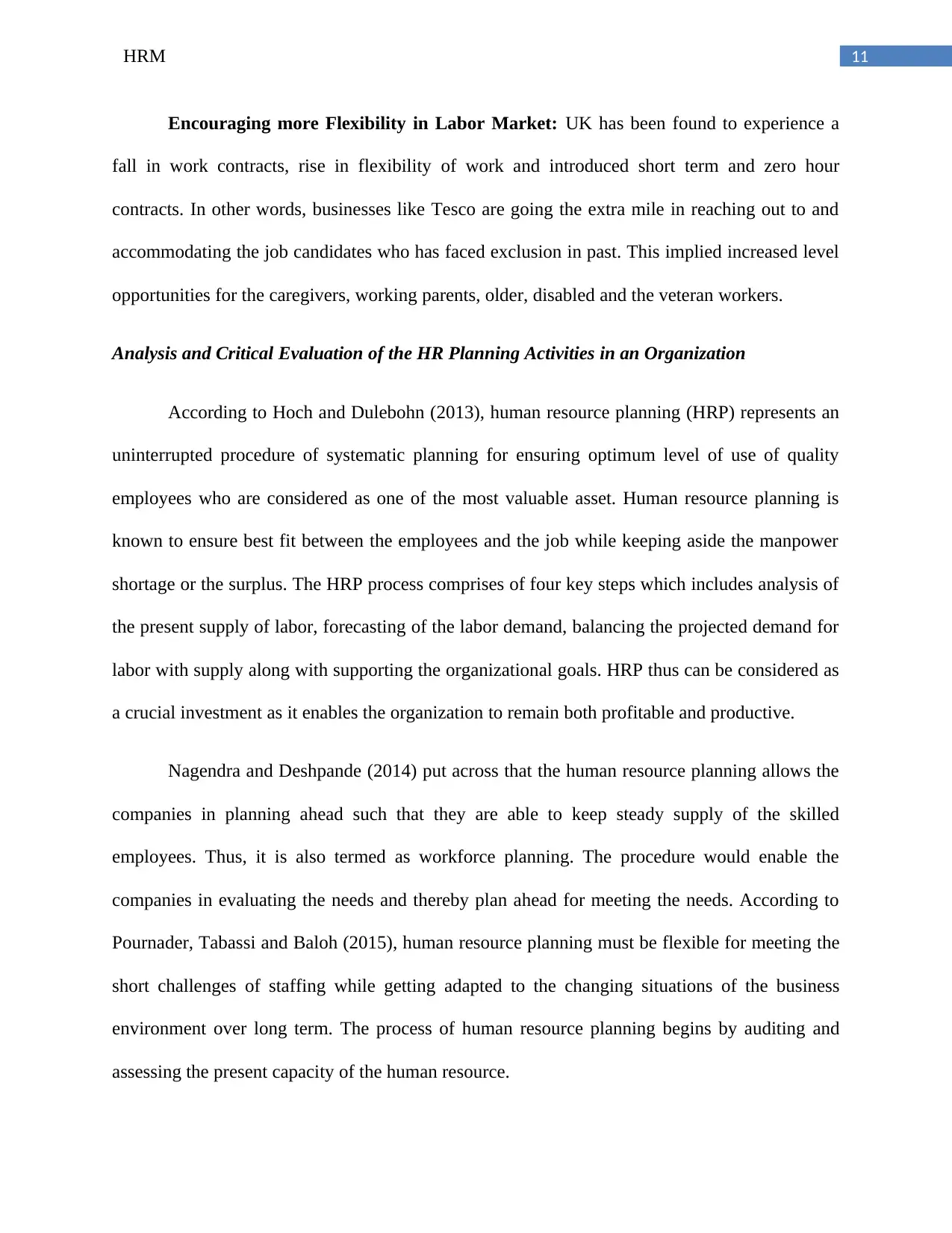
11HRM
Encouraging more Flexibility in Labor Market: UK has been found to experience a
fall in work contracts, rise in flexibility of work and introduced short term and zero hour
contracts. In other words, businesses like Tesco are going the extra mile in reaching out to and
accommodating the job candidates who has faced exclusion in past. This implied increased level
opportunities for the caregivers, working parents, older, disabled and the veteran workers.
Analysis and Critical Evaluation of the HR Planning Activities in an Organization
According to Hoch and Dulebohn (2013), human resource planning (HRP) represents an
uninterrupted procedure of systematic planning for ensuring optimum level of use of quality
employees who are considered as one of the most valuable asset. Human resource planning is
known to ensure best fit between the employees and the job while keeping aside the manpower
shortage or the surplus. The HRP process comprises of four key steps which includes analysis of
the present supply of labor, forecasting of the labor demand, balancing the projected demand for
labor with supply along with supporting the organizational goals. HRP thus can be considered as
a crucial investment as it enables the organization to remain both profitable and productive.
Nagendra and Deshpande (2014) put across that the human resource planning allows the
companies in planning ahead such that they are able to keep steady supply of the skilled
employees. Thus, it is also termed as workforce planning. The procedure would enable the
companies in evaluating the needs and thereby plan ahead for meeting the needs. According to
Pournader, Tabassi and Baloh (2015), human resource planning must be flexible for meeting the
short challenges of staffing while getting adapted to the changing situations of the business
environment over long term. The process of human resource planning begins by auditing and
assessing the present capacity of the human resource.
Encouraging more Flexibility in Labor Market: UK has been found to experience a
fall in work contracts, rise in flexibility of work and introduced short term and zero hour
contracts. In other words, businesses like Tesco are going the extra mile in reaching out to and
accommodating the job candidates who has faced exclusion in past. This implied increased level
opportunities for the caregivers, working parents, older, disabled and the veteran workers.
Analysis and Critical Evaluation of the HR Planning Activities in an Organization
According to Hoch and Dulebohn (2013), human resource planning (HRP) represents an
uninterrupted procedure of systematic planning for ensuring optimum level of use of quality
employees who are considered as one of the most valuable asset. Human resource planning is
known to ensure best fit between the employees and the job while keeping aside the manpower
shortage or the surplus. The HRP process comprises of four key steps which includes analysis of
the present supply of labor, forecasting of the labor demand, balancing the projected demand for
labor with supply along with supporting the organizational goals. HRP thus can be considered as
a crucial investment as it enables the organization to remain both profitable and productive.
Nagendra and Deshpande (2014) put across that the human resource planning allows the
companies in planning ahead such that they are able to keep steady supply of the skilled
employees. Thus, it is also termed as workforce planning. The procedure would enable the
companies in evaluating the needs and thereby plan ahead for meeting the needs. According to
Pournader, Tabassi and Baloh (2015), human resource planning must be flexible for meeting the
short challenges of staffing while getting adapted to the changing situations of the business
environment over long term. The process of human resource planning begins by auditing and
assessing the present capacity of the human resource.
⊘ This is a preview!⊘
Do you want full access?
Subscribe today to unlock all pages.

Trusted by 1+ million students worldwide
1 out of 20
Related Documents
Your All-in-One AI-Powered Toolkit for Academic Success.
+13062052269
info@desklib.com
Available 24*7 on WhatsApp / Email
![[object Object]](/_next/static/media/star-bottom.7253800d.svg)
Unlock your academic potential
Copyright © 2020–2025 A2Z Services. All Rights Reserved. Developed and managed by ZUCOL.




